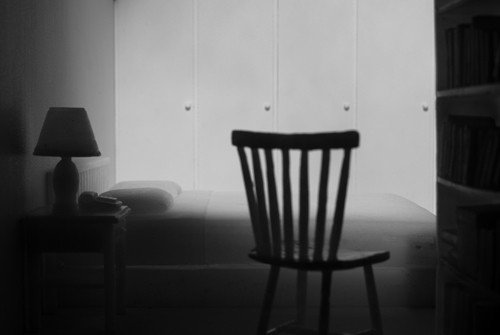Jonas Dahlberg
dal 16/6/2008 al 19/9/2008
Segnalato da
16/6/2008
Jonas Dahlberg
Magazzino d'Arte Moderna, Roma
Three Rooms is an installation consisting of 3 large screens separated by gaps of 1.5-2 metres in a black, silent room. The spectator cannot avoid the impression of seeing a living room, a dining room and a bedroom on the screens. During the course of 26 minutes the objects in the rooms dissolve, leaving only the lighting and the bare space. Objects which are thin disappear gradually.

Magazzino d’Arte Moderna is pleased to present Swedish artist Jonas Dahlberg’s new video installation, Three Rooms.
Three Rooms is an installation consisting of three large screens separated by gaps of 1.5-2 metres in a black, silent room. The three different rooms shown on the three screens are similarly lit, accommodating shadow and shade, similarly occupied by generic modern domestic objects and of a similar spatiality. The spectator cannot avoid the impression of seeing a living room, a dining room and a bedroom on the screens. During the course of twenty-six minutes the objects in the rooms dissolve, leaving only the lighting and the bare space. Objects which are thin disappear gradually. Other thicker objects whose mass is unevenly distributed involve a process of falling over and breaking before they, too, disappear. As the objects degrade the rooms seem transformed into landscapes of dissolution and finally we are left with a vacancy defined only by the light and the planes of the wall.
This visual experience, however, is not independent. It is subject to the duration of the installation and the way in which time works within it. At one level the passage of time seems slow. We wait and nothing happens. But at another level it seems infinitely fast. Both are true. The effect of slowness is because the events of the video take place at a slower rate than we normally associate with movement and especially with destruction. The destruction of objects is normally experienced as a break in time rather than the use of prolonged duration. At the same time the video is experienced as an immense speeding up of events. We realize we are watching not a scene of violence or destruction but rather, an infinitely slow natural process of decay, erosion and dissolution. The time of this process is not chronological time but some other kind of time. We might think of it almost as biological or geological time. This corresponds in the video to the fact that at a certain point when the objects of a domestic room have already degraded, we pass into what looks more like a landscape of partial objects and finally into a desert which shows only the indecipherable footprints of objects.
Dahlberg has found a way to abolish objects through a process which is uniform and slow and therefore akin to a natural process whether we think of evolution or ecological change or geological causality – all slow, uniform pressures. The video stays calmly and grimly with the logic of what causes the object to disappear. The spectator who wishes to explain what he sees in terms of ‘events’ will experience the collapse of the shade of a standard lamp as a sudden event as a way of providing a narrative. But what the video shows us is a causality which cannot be reduced to a narrative. The account of the unmaking of objects shows, in one way or another, the triumph of matter over form. Central here is a certain reworking of ideas of nature. If nature were thought of, as it often has been, as a certain potentiality and fecundity of forms, then the scene enacted in Dahlberg’s installation might traditionally be thought of as the occasion for the experience of sublimity in which the subject realizes that ultimately the vastness of the universe reduces him, not to an irrelevant particle, but rather teaches the subject the true and infinite scale of its subjectivity.
But here, in the unblinking gravity of Three Rooms we see a nature bent only towards the erosion and the erasure of all forms. For the spectator, the outcome is a desolation beyond subjectivity.
Marc Cousins, Architectural Association, London and The London Consortium (University of London).
Opening 17 June
Magazzino d'Arte Moderna
via dei Prefetti, 17 - Roma
Free admission



